Closet Chaos Conquering: 4 Apps to Turn Your Old Clothes into Cash!
Does your closet resemble a fashion warzone? Clothes overflowing, unworn treasures gathering dust, and a nagging feeling that it's time for a major declutter session? Well, fret no more, fashion warriors!
- Entrefemme
- May 15, 2025
- 0 Comments
- 3298 Views
This article unveils your secret weapon for conquering closet chaos and turning those unworn outfits into cash. We'll explore 4 amazing apps that make selling your used clothes a breeze. From trendy tops to timeless handbags, get ready to breathe new life into your wardrobe and transform your overflowing closet into a treasure trove of opportunity! So, grab a cup of coffee, sort through those stylish cast-offs, and get ready to cash in on your pre-loved fashion finds!
I have a confession to make: I had accumulated so many clothes at home that I thought I could get rich by selling them. However, after two months, I had only managed to sell three items. At that time, I wasn't yet familiar with local and international apps that facilitate sales. Occasionally, a little extra money in dollars or euros can't hurt, right? That's why I'm going to introduce you in this article to four apps available on the Europe and US markets for those who want to sell and make a small profit. It's important to note that this doesn't mean only European can buy from european sellers and English speakers from English sellers. Exporting to other countries is entirely possible.
I. Europe Market
Selling your used clothes and household items has become easier than ever thanks to mobile apps. Whether you want to declutter your home or earn a little extra cash, these apps offer user-friendly platforms to connect with buyers. Here are my top picks:
1. Vinted
- Overview: Vinted is an app dedicated to selling used clothing, shoes, accessories, and household items.
- Launch: Founded in 2008, Vinted has become particularly popular in Europe over the past few years as a platform for selling second-hand clothing.
- Features: Easy photo uploads, integrated messaging for buyer communication, and a user-friendly interface for browsing listings.
- Advantages: Popular platform in Europe, transparent transaction fees, and an active community of sellers and buyers.
- Disadvantages: High competition for popular items, service fees applied to sales.
2. Leboncoin
- Overview: Leboncoin is a well-established platform in France for selling a wide range of items, including clothes and household goods.
- Launch: Founded in 2006, Leboncoin has become a reference in France for selling second-hand goods of all kinds, including clothes and household items.
- Features: Free ads for individuals, ability to manage ads via the mobile app or website.
- Advantages: Large local audience, no fees for most ads, and the ability to negotiate directly with buyers.
- Disadvantages: Less focused on fashion compared to other specialized apps, self-managed transactions.
3. Vestiaire Collective
- Overview: Vestiaire Collective focuses on reselling luxury and high-end fashion clothing and accessories.
- Launch: Founded in 2009, Vestiaire Collective has established itself as a leading platform for reselling luxury fashion items.
- Features: Item authentication, dedicated customer service, and the ability to sell renowned designer pieces.
- Advantages: Specialized market for luxury items, secure sales process, and support for shipping management.
- Disadvantages: Higher commission fees for sales, rigorous selection of accepted items.
4. Facebook Marketplace
- Overview: Facebook Marketplace allows local selling of various items, including clothes and household goods.
- Launch: Launched in 2016, Facebook Marketplace is an integrated platform on Facebook for buying and selling a variety of items locally, including clothes and household items.
- Features: Integration with Facebook profiles, free listings, and the ability to join local buying/selling groups.
- Advantages: Large local audience, trust established through Facebook profiles, and no fees for most transactions.
- Disadvantages: Less focused on fashion compared to dedicated apps, need to be active on Facebook for maximum visibility.
II. US Market
1. Vinted
- Overview: Vinted is an app dedicated to selling used clothing, shoes, accessories, and household items.
- Launch: Founded in 2008, Vinted has become particularly popular in Europe over the past few years as a platform for selling second-hand clothing.
- Features: Easy photo uploads, integrated messaging for buyer communication, and a user-friendly interface for browsing listings.
- Advantages: Popular platform in Europe, transparent transaction fees, and an active community of sellers and buyers.
- Disadvantages: High competition for popular items, service fees applied to sales.
2. eBay
- Overview: eBay is a well-established platform for selling a wide range of items, including clothing and household goods.
- Launch: Founded in 1995, eBay has grown into a global marketplace for buying and selling a wide range of items, including clothing and household goods.
- Features: Global marketplace, auction-style and fixed-price listings, seller protections, and shipping options.
- Advantages: Large international audience, ability to reach niche markets, and various selling formats.
- Disadvantages: Fees for listings and final value fees, competition from professional sellers.
3. Poshmark
- Overview: Poshmark specializes in selling fashion items, including clothing, shoes, and accessories.
- Launch: Founded in 2011, Poshmark has become known for its social marketplace approach to selling fashion items like clothing, shoes, and accessories.
- Features: Social marketplace, sharing and following features, in-app payments, and seller protections.
- Advantages: Dedicated fashion community, easy sharing on social media, and seller support.
- Disadvantages: Higher seller fees compared to some platforms, competitive market for fashion items.
4. Facebook Marketplace
- Overview: Facebook Marketplace allows local selling of various items, including clothes and household goods.
- Launch: Launched in 2016, Facebook Marketplace is an integrated platform on Facebook for buying and selling a variety of items locally, including clothes and household items.
- Features: Integration with Facebook profiles, free listings, and the ability to join local buying/selling groups.
- Advantages: Large local audience, trust established through Facebook profiles, and no fees for most transactions.
- Disadvantages: Less focused on fashion compared to dedicated apps, need to be active on Facebook for maximum visibility.
Whether you're looking to clear out your closet or earn some extra cash, these apps provide versatile solutions for selling used clothing and household items. From specialized platforms like Vinted and Poshmark to broader marketplaces such as eBay and Facebook Marketplace, each app offers unique features tailored to different needs and preferences.
In the French market, apps like Vinted, Leboncoin, Vestiaire Collective, and Facebook Marketplace cater to a variety of sellers, from those looking to sell luxury items to those simply decluttering their homes. These platforms not only offer local visibility but also the potential to reach international buyers, making it easier to expand your selling reach beyond borders.
On the English market side, eBay stands out with its global reach and auction-style listings, while Poshmark excels in creating a social community around fashion resale. Both platforms, along with Facebook Marketplace, provide accessible ways to connect with buyers locally and globally, ensuring a seamless selling experience.
Whether you're a fashion enthusiast looking to upgrade your wardrobe or someone looking to turn unused items into cash, exploring these apps can simplify the selling process and maximize your earnings. Remember, each platform has its strengths and it's worth experimenting to find the best fit for your selling needs.

 | Unlock Success with Our Guide
| Unlock Success with Our Guide



0 Comments